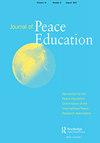The conception of war and peace in early childhood: a phenomenological analysis of kindergarten children in Banten, Indonesia
IF 1.3
Q3 EDUCATION & EDUCATIONAL RESEARCH
引用次数: 0
Abstract
ABSTRACTIn recent decades, numerous studies have been conducted on children’s understanding of peace and war. Geographic, economic, political, cultural, and social differences influence the concepts of war and peace. This study aims at examining this effect. In addition to comparing studies conducted in Western countries, the study aims to examine early childhood students’ understanding of war and peace concepts. The study involved ten early childhood children who were at the kindergarten level with an average age of 5.7 years. The study employed a phenomenological approach. Drawing and semi-structured interviews were utilized for data collection. The study results indicate that children conceptualize war as unhappiness, conflict, and weapons. War concepts are symbolized by sad people, weapons, and fighting characters. In addition, children conceptualize peace as happiness, the beauty of nature, and a place that makes them feel safe, cheerful, free to express themselves, happy, and in which no one is angry. Smiling people, houses, trees, rainbows, and mountains represent peace. Overall, early childhood simultaneously comprehends the concepts of war and peace. This result differs from those of several prior studies.KEYWORDS: Children’s drawingchildren’s understandingpeace conceptspeace education in childrenphenomenologywar concepts Disclosure statementNo potential conflict of interest was reported by the author(s).Additional informationFundingThis research received funding from Lembaga Pengelola Dana Pendidikan (LPDP) of the Republic of Indonesia with Grant number 2020031130770.Notes on contributorsIlfiandra IlfiandraIlfiandra is an Associate Professor of guidance and counseling with a research focus on peace education and pedagogy. He has been conducting research in peace education and pedagogy since 2012. He leads the Center for Peace Education and Pedagogy Studies at Universitas Pendidikan Indonesia. Under his leadership, the study center organized training activities to develop peace educator competencies for teachers in West Java Province, Indonesia. He also succeeded in developing the “Development and Validation Peaceful Classroom Scale: Rasch Model Analysis (Ilfiandra et al., Citation2022),” published in the International Journal of Instruction. His research findings in the book Bibliokonseling untuk Membangun Budaya Damai di Sekolah (Bibliocounseling to Build a Culture of Peace in Schools) (Ilfiandra et al., Citation2021) have also become a guide for Indonesian guidance and counseling teachers in developing a culture of peace in schools. Ilfiandra and Saripudin (Citation2023) also developed an ethnopedagogy model from the traditional values of the Sundanese indigenous people in Indonesia.Mohamad SaripudinMohamad Saripudin is a researcher in peace education and pedagogy. He founded a research organization, CARE Institute, with Amirul Hazmi Hamdan & Nur Asiah. He is also a lecturer at Universitas Sultan Ageng Tirtayasa, Indonesia. He developed a model training program to develop the competence of kindergarten teachers as peace educators. One of his scholarly works on peace education is about film as a medium for developing a culture of peace (Saripudin et al. Citation2023). This article appears in the journal Media Asia.幼儿时期战争与和平的概念:对印尼万丹幼儿园儿童的现象学分析
近几十年来,关于儿童对和平与战争的理解进行了大量的研究。地理、经济、政治、文化和社会的差异影响着战争与和平的概念。本研究旨在检验这一效应。除了比较西方国家的研究外,本研究还旨在考察幼儿学生对战争与和平概念的理解。这项研究涉及10名平均年龄为5.7岁的幼儿园幼儿。这项研究采用了现象学的方法。数据收集采用绘图和半结构化访谈。研究结果表明,儿童对战争的概念是不快乐、冲突和武器。战争概念的象征是悲伤的人、武器和战斗人物。此外,孩子们将和平理解为幸福、自然之美,以及一个让他们感到安全、快乐、自由表达自己、快乐、没有人生气的地方。微笑的人、房子、树、彩虹和山都代表着和平。总的来说,幼儿期同时理解战争与和平的概念。这一结果与之前的几项研究结果不同。关键词:儿童绘画;儿童对和平概念的理解;儿童空间教育;现象学;本研究获得了印度尼西亚共和国Lembaga Pengelola Dana Pendidikan (LPDP)的资助,资助号为2020031130770。作者简介:IlfiandraIlfiandra是一名指导和咨询副教授,研究重点是和平教育和教育学。自2012年以来,他一直从事和平教育和教育学的研究。他领导着印尼彭迪迪肯大学和平教育与教育学研究中心。在他的领导下,研究中心为印尼西爪哇省的教师组织了培训活动,以发展和平教育者的能力。他还成功开发了“和平课堂量表的开发与验证:Rasch模型分析(Ilfiandra et al., Citation2022)”,发表在《国际教学杂志》上。他在《biblioconseling untuk Membangun Budaya Damai di Sekolah (Bibliocounseling to Build a Culture of Peace in Schools)》一书中的研究成果(Ilfiandra et al., Citation2021)也成为印尼指导和咨询教师发展学校和平文化的指南。Ilfiandra和Saripudin (Citation2023)还根据印度尼西亚巽他人的传统价值观发展了一种民族教育学模型。Mohamad Saripudin是和平教育和教育学的研究人员。他与Amirul Hazmi Hamdan & Nur Asiah共同创立了一个研究机构CARE Institute。他也是印度尼西亚苏丹阿贡蒂塔亚萨大学的讲师。他制定了一个模范培训计划,以培养幼儿园教师作为和平教育者的能力。他在和平教育方面的学术著作之一是关于电影作为发展和平文化的媒介(Saripudin等)。Citation2023)。本文发表于《亚洲传媒》杂志。
本文章由计算机程序翻译,如有差异,请以英文原文为准。
求助全文
约1分钟内获得全文
求助全文

 求助内容:
求助内容: 应助结果提醒方式:
应助结果提醒方式:


